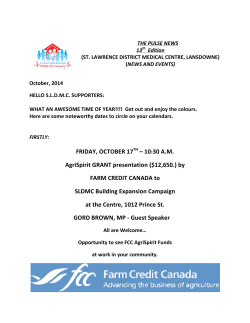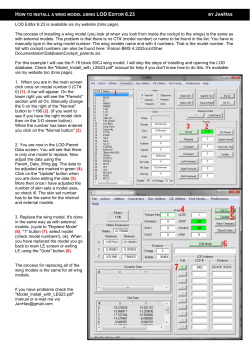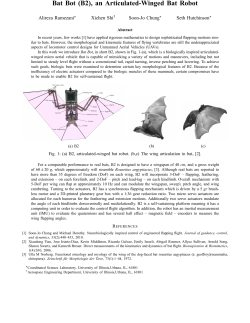
WING ECOMORPHOLOGY OF SEABIRDS FROM JOHNSTON ATOLL`
The Condor 101:549-556 ? The Cooper Ornithological Society 1999 WING ECOMORPHOLOGYOF SEABIRDS FROM JOHNSTONATOLL' FRITzHERTEL Departmentof Biology, Universityof California,Los Angeles, CA 90095-1606, e-mail:fhertel@ucla.edu LISA T. BALLANCE Ecology Program,NOAA,NMFS,SouthwestFisheries Science Center,8604 La Jolla Shores Drive, La Jolla, CA 92037 Abstract. Wing morphologyof nine species of seabirdsfrom JohnstonAtoll in the central tropicalPacific was analyzed to determinehow wing size and shape correlatedwith observed foraging behaviorand, in some species, the energetic cost of flight. Red-tailed Tropicbirds(Phaethon rubricauda)and ChristmasShearwaters(Puffinusnativitatis)had lower wing areas, shorterwing spans, and higher relative wing loading than would be predictedfrom mass alone. Brown Noddies (Anousstolidus)and Red-footedBoobies (Sula sula) had lower wing loading, Brown Boobies (Sula leucogaster)and Sooty Terns(Sterna fuscata) had higheraspectratios,and Brown Noddies had lower aspectratiothanwould be predictedfrom mass alone. Aspect ratioshowed greaterintraspecificvariationthanthe other variables.In most cases, predicteddifferencesin wing morphologycorrelatedwell with observedforagingdifferencesamongspecies, and species thatdid not differ significantlyin body mass differed with respect to wing size and shape; these morphologicaldifferences reflectedvarying flight and foragingbehaviors.Sooty Ternshad a higher aspect ratio and higherwing loadingthanBrown Noddies reflectingtheirmore pelagic lifestyle, and Christmas Shearwatershad a lower aspectratioandhigherwing loadingthanWedge-tailedShearwaters(Puffinuspacificus)reflectingtheirpursuitplungingbehavior. Keywords: ecomorphology,flight, Laridae,Phaethontidae,Procellariidae,seabirds,Sulidae, wings. INTRODUCTION Morphological studies usually provide important insights into the relationship between organisms and their ecology, because morphological structures are intimately linked to performance, and performance determines the suite of ecological strategies available to a species. Interspecific variation in morphology is indicative of the different roles played by each species within a community, however the success of characterizing these roles depends on choosing the appropriate morphological features that correspond with the performance character of interest. Flight is a performance parameter about which much can be learned through the study of ecomorphology. For almost all birds, flight is intimately linked with a suite of morphological traits, all of which are interdependent and relatively highly constrained. Pelagic seabirds provide an intriguing system in which to study ecomorphological aspects of flight. The spatial scale of pelagic systems is large relative to terrestrial ones (McGowan and ' Received 2 July 1998. Accepted22 March 1999. Walker 1993), and some pelagic seabird species traverse hundreds or thousands of kilometers per day on a regular basis in search of food (Strikwerda et al. 1986, Jouventin and Weimerskirch 1990). This is particularly true in the tropics, where productivity is low relative to high latitudes (Ainley and Boekelheide 1993, Ballance and Pitman 1999), and thus there should be strong selection for flight capabilities that allow seabirds to locate and secure prey in the face of diminished feeding opportunities. Some tropical seabirds such as Sooty Terns (Sterna fuscata) and Red-footed Boobies (Sula sula) have metabolic costs of flight much lower than would be predicted based on body mass alone (Flint and Nagy 1984, Ballance 1995), and they exhibit behavioral adaptations that increase flight proficiency, including the use of wind as an energy source (Pennycuick 1982, Ballance 1995, Spear and Ainley 1997). Given these physiological and behavioral adaptations, it is expected that morphological adaptations also exist for proficient flight. Warham (1977, 1996) presented data for several procellariiform species that revealed how wing morphology reflected ecology. For exam- [549] This content downloaded from 130.166.34.124 on Tue, 05 May 2015 23:04:44 UTC All use subject to JSTOR Terms and Conditions 550 FRITZ HERTEL ANDLISA T. BALLANCE TABLE 1. Species sampledfrom JohnstonAtoll. Valuesrepresentmean ? SE. Wing loadingin Newtonsm-2. Species Procellariiformes Wedge-tailedShearwater ChristmasShearwater Pelecaniformes Brown Booby MaskedBooby Red-footedBooby Red-tailedTropicbird Charadriiformes Sooty Tern Brown Noddy White Tern n Mass (kg) Aspect ratio Wing loading (N m-2) Wing span (m) Wing area (m2) 40 0.38 ? 0.01 12 0.34 ? 0.01 10.41 ? 0.06 37.94 + 0.63 1.01 ? 0.01 10.34 ? 0.78 51.51 ? 1.48 0.82 ? 0.02 0.10 ? 0.001 0.07 ? 0.001 14 7 42 15 12.14 + 12.16 + 11.43 + 10.92 + 0.19 ? 0.22 ? 0.20 ? 0.11 ? 1.26 ? 1.90 ? 1.10 ? 0.65 ? 0.06 0.06 0.02 0.02 0.13 0.29 0.09 0.08 64.06 + 2.38 84.76 3.13 54.98 ?_ 0.78 56.67 ? 1.49 1.52 ? 1.64 ? 1.50 ? 1.11 ? 0.06 0.03 0.01 0.01 0.004 0.005 0.002 0.001 27 0.20 ? 0.01 11.23 + 0.10 26.92 ? 0.39 0.90 ? 0.004 0.07 ? 0.001 30 0.19 ? 0.003 9.67 + 0.06 23.38 ? 1.89 0.85 ? 0.004 0.08 ? 0.001 2 0.11 ? 0.003 11.12 ? 0.12 23.54 ? 0.76 0.70 ? 0.001 0.04 ? 0.001 ple, diving-petrels (Pelecanoididae), which pursue prey underwater using wing propulsion, showed convergent morphological adaptations with auks (Alcidae), which also pursue prey underwater by using their wings. Other studies have suggested that certain wing traits are associated with low energetic cost of flight in seabirds; Southern Giant Petrels (Macronectes giganteus) are similar in mass to some albatrosses but have differently shaped wings and greater flight costs (Pennycuick 1982, Obst and Nagy 1992). Tropical seabirds must be selected for proficient flight, especially in comparison with high latitude seabirds. They also exhibit a diversity of flight behaviors that reflect ecological differences in searching for and acquiring prey (Ashmole 1971). In this paper we examine the wing morphology of nine seabird species in the tropical Pacific with the premise that wing morphology reflects these ecological differences. Morphological differences are used to make predictions about ecology, which are based on results from previous studies (Norberg 1985, 1989, Rayner 1988, Pennycuick 1989) and are tested by investigating what is known about the distribution and feeding ecology of these seabirds. METHODS STUDY AREA AND SPECIES Johnston Atoll, a group of four small islands (each - 2.5 km2), is located approximately 1,200 km southwest of Hawaii in the eastern tropical Pacific (16045'N, 16931 'W). Vegetation consists of 3 native and 124 introduced species (Amerson and Shelton 1976). Thirteen species of seabirds currently breed on the atoll and 9 of these, representing three orders and four families of birds, were sampled for this study (Table 1). Birds were live-captured, measured, and released unharmed within a period of 8 min. All species were sampled during the breeding season (incubating, brooding, and/or provisioning young). The feeding behavior of each species was categorized based on their most typical feeding behavior as determined by Ashmole (1971) and from our own field observations. DATA COLLECTION Measurements were collected following the methods outlined by Pennycuick (1989). Body mass (kg), wing length (m), and wing area (m2) were recorded for each bird. Wing length was calculated as the rectilinear distance from the sternum, a homologous landmark, to the tip of the outstretched wing along the ventral surface of the bird; wing span was thus twice the wing length (Fig. 1). The fully outstretched wing was traced with the wing positioned ventral side down. This tracing (partial wing area) was later digitized using the program SIGMASCAN (Jandel Corp., San Rafael, California) to determine its area. The tracing was shorter than the wing length because of the body area between the proximal edge of the wing and sternum, known as the root box (Pennycuick 1989). This rectangular area was quantified by multiplying the width of the wing where it meets the body, and the difference between the wing length and the length of the wing tracing (Fig. 1). The root box was added to the partial wing area, thus wing area was twice this value (Fig. 1). This content downloaded from 130.166.34.124 on Tue, 05 May 2015 23:04:44 UTC All use subject to JSTOR Terms and Conditions SEABIRDWINGECOMORPHOLOGY551 results are conductedwithin the context of seabirds. WingLength IN i? PartialWingArea Root Box takenof the wing.Wing FIGURE1. Measurements lengthmeasuredfromthe sternumto the tip of the wing,thuswingspan= 2 X winglength.Partialwing areacalculatedfroma tracingof the birdwing.Root the widthof the wing box quantified by multiplying whereit meetsthe body by the differencebetween winglengthandpartialwinglength,thuswingarea= 2 X (rootbox + partialwingarea). These data were used to calculatewing loading and aspectratio,the lattera size-independent variablethat can contain significantinformation (Norbergand Norberg 1988, Rayner 1988). Aspect ratio, a dimensionless number that describes the shape of the wing, was calculatedas: wing span2/wingarea DATAANALYSIS No sexual distinctionwithin species was made in these analyses either because there was no apparentsexual dimorphismor sample sizes between known sexes were too small for statistical analyses. To determinewhetherthere was a biased effect from species with largersample sizes, a species mean was generatedfor all variables and used in all analyses;these resultswere compared with analyses using individual data. Results were similarin all but one case (see below), thereforeonly results for individuals are presented. A Pearsoncorrelationmatrixwas generatedto show relationshipsamong all variables. Body size is an importantecological variable, therefore least-squares regressions of logi0-transformed variables(wing area, wing span, aspect ratio, and relative wing loading) were used to investigate allometric relationships between each of these variablesand log body mass; the mean absolute value of residuals from the regression indicatedwhich species deviated most for each variable.Species similar in body mass were examinedfor significantdifferencesin other variables. Body mass, relativewing loading, and aspect ratio were used to constructa multidimensional morphospace,which provided a graphicalrepresentationof the relationshipsamong all species. Axes were representedas standarddeviates of the mean value for each variable.All analyses were done using SYSTAT(Wilkinson1988). Higher values for this index indicate a comparatively narrowerwing, and lower values a comparativelybroaderwing. Wing loadingdescribesthe weight (force) that is borne per unit area of the wings, or the amount of weight carriedby the bird's wings; the units are in Newtons (force) m-2. It was cal- RESULTS culated as: AMONGVARIABLES CORRELATIONS statistics for body mass and wing pabody mass X gravitationalconstant (a)/wing Summary rameters are in Table 1. Ourresultsfor the given area two shearwaters agree closely with those of Largerbirds typically have a higher wing load- Warham(1977, 1996). Analysis of individual ing than smaller birds because of area-volume specimens showed a significant correlation scaling relationships (Hildebrand 1988). Nor- among body mass, wing loading, aspect ratio, berg and Norberg (1988) used relative wing wing span, and wing area (r > 0.59, P < 0.001 loading (wing loading divided by the cube root for all variables).The lowest correlationswere of body mass) for comparisonswith geometric between aspect ratio and each of the other varsimilarityand to help account for the effects of iables (0.59 < r < 0.68). Analysis of species body size; thus relative wing loading also was means indicateda similartrendwith one excepused in this analysis. As a group, seabirdstypi- tion, aspect ratio. Body mass, wing loading, cally have long, narrow wings compared with wing span, and wing area were all significantly most other birds, and so our comparisonsand correlated(r > 0.84, P < 0.001 for all vari- This content downloaded from 130.166.34.124 on Tue, 05 May 2015 23:04:44 UTC All use subject to JSTOR Terms and Conditions 552 FRITZ HERTEL ANDLISA T. BALLANCE 0.53X - 0.77; Fig. 2b), and with relative wing loading (R2 = 0.35, P < 0.001; Y = 0.14X + 1.77; Fig. 2c). The exception was aspect ratio; this relationship was not significant (R2 = 0.36, P = 0.06; Y = 0.06 X + 1.06; Fig. 2d), and intraspecific variation tended to be greater for this variable than the other measures of wing morphology. Mean regression residuals were generally greatest for two species, which also were farthest from the 95% confidence intervals, Redtailed Tropicbirds (Phaethon rubricauda) and Christmas Shearwaters (Puffinus nativitatis). Both had shorter wing spans, lower wing areas, and higher relative wing loading than would be predicted from mass alone (Figs. 2a-c, respectively). Brown Noddies (Anous stolidus) and Red-footed Boobies (Sula sula) had greater negative residual values for wing loading, suggesting they have a relatively lower than predicted wing loading (Fig. 2c). Mean residual values of aspect ratios were most positive for Brown Boobies (Sula leucogaster) and Sooty Terns (Sterna fuscata), suggesting higher aspect ratios (narrower wings); mean residual values were most negative for Christmas Shearwaters and Brown Noddies, suggesting lower aspect ratios (wider wings) (Fig. 2d). z cS.1 w o z_ 0 -.1 -5 T sT . b -.7 w B o z N 3. -1.1': 0 0 . T x s -1.5 C 2 z S1.8 s 0 j S1.6 0 N 1.5 1.16 dM S S1.12 S1.08 -.8 - -A 2 -2 A D 1.04O SPECIESSIMILARIN BODY MASS c, oR X " .96 .92 -12 -1 -.8 -A -2 0 -.6 LOG BODYMASS (kg) 2 A .6 FIGURE 2. Least-squaresregressionson log body mass for seabirdspecies from JohnstonAtoll for (a) log wing span, (b) log wing area,(c) log relativewing loading, and (d) log aspect ratio. Letter codes: B = Brown Booby, F = White Tern, M = Masked Booby, N = Brown Noddy, R = Red-footed Booby, S = Sooty Tern, T = Red-tailed Tropicbird, W = Wedge-tailed Shearwater,X = ChristmasShearwater. ables), however there was no significant correlation between aspect ratio and any other variable (r < 0.78, P > 0.1). REGRESSIONSWITHLOG BODY MASS In general, body mass was a better predictor of wing size than wing shape. There was a significant relationship of body mass with wing span (R2 = 0.90, P < 0.001; Y = 0.30X 2a), wing area (R2 = 0.89, + 0.14; Fig. P < 0.001; Y = ANOVA for all species indicated two species pairs that did not differ significantly in body mass. Sooty Terns and Brown Noddies (hereafter, tern-noddy pair) did not show body mass differences, but were significantly different with respect to all wing parameters (P < 0.001 for all values). The small sample size (n = 2) for White Terns (Gygis alba) precluded their use for statistical comparisons. Wedge-tailed Shearwaters (Puffinus pacificus) and Christmas Shearwaters also did not differ in body mass but showed significant differences for all wing parameters (P < 0.001) with the exception of aspect ratio (P > 0.5). GROUPDIVERSITY A three-dimensional plot of body mass, aspect ratio, and relative wing loading depicted how species segregated along these axes (Fig. 3). A nested ANOVA showed significant differences at the family and genus level for each variable; boobies and tropicbirds (Pelecaniformes) had greater values for all three variables, terns This content downloaded from 130.166.34.124 on Tue, 05 May 2015 23:04:44 UTC All use subject to JSTOR Terms and Conditions SEABIRDWING ECOMORPHOLOGY 553 aspect ratio and each of the other variables is partly a result of it being a dimensionless number in which the effect of size has been minimized. The coefficient of variation for aspect ratio was greater than for any other variable and in all species. As mentioned previously, size-independent variables are important for illustrating adaptive significance (Norberg and Norberg 1988, Rayner 1988), thus particular attention is given to aspect ratio. With respect to our study, the intraspecific variation in aspect ratio suggests fewer constraints on this variable than other parameters of wing morphology. 2 1B 0 -2 212 -1 ---1 1Loading wn tRelat're FIGURE 3. Three-dimensional morphospace for body mass, relativewing loading, and aspectratiofor seabird species from JohnstonAtoll. Axes plotted as standarddeviates of the mean value for each index. Lettercodes as in Figure2. Pelecaniformes(B, M, R, T) had greatervalues for all three variables,Charadriiformes (F, N, S) showed the converse, and Procellariiformes(W, X) had intermediatevalues except for aspect ratio, which was similarto Charadriiformes. (Charadriiformes) showed the converse, and shearwaters (Procellariiformes) had intermediate values except for aspect ratio, which was similar to terns (Table 1, Fig. 3). DISCUSSION BODY SIZE Not surprisingly, variables with the highest correlations among each other reflected some measure of size: wing span, wing area, body mass, and to a lesser extent wing loading. Body size is an important determinant of feeding flock composition in the tropical Pacific, particularly in flocks in which boobies were the numerically dominant species (Ballance et al. 1997). Larger body size was important for gaining access to prey while potentially excluding others from the same. In addition, Brown Boobies and Masked Boobies (Sula dactylatra) typically feed by plunge diving, where they enter the water, often from great heights, to seize prey below the surface (Ashmole 1971, Hoyo et al. 1992, Ballance et al. 1997). Masked Boobies are the largest boobies and their size allows them to plunge deeper than Brown Boobies, providing access to prey potentially unavailable to a smaller species. The comparatively low correlations between MORPHOLOGICAL PREDICTIONSOF ECOLOGY Results from empirical and theoretical research designed to determine general relationships between wing morphology and flight performance can be used in this particular study to predict ecology from morphology. For example, aspect ratio might be used as a predictor of distance traveled when foraging; the more far-ranging the species, the higher the aspect ratio (Norberg 1985, Rayner 1988). This relationship is exemplified by albatrosses, among the most far-ranging of seabirds (Jouventin and Weimerskirch 1990) and those with the highest aspect ratios (Hildebrand 1988, Warham 1996). Similarly, wing loading might be used as a predictor of distance traveled when foraging because the energetic cost of flight is likely to be positively correlated with wing loading. For example, Obst and Nagy (1992) found that Southern Giant Petrels (Macronectes giganteus) had greater flight costs, higher wing loading, and lower aspect ratio than several albatrosses of similar mass; the former regularly feed on shore or in nearshore waters, whereas the latter rarely do so (Harrison 1983, Hoyo et al. 1992). A third prediction is that wing loading will be negatively correlated with glide/flight speed (Pennycuick 1989). Thus, we would predict that only those species with relatively low wing loading will be able to utilize foraging strategies that require low flight speeds. This would be especially important in tropical regions where wind speeds are typically lower compared with winds at higher latitudes. Tern-noddy pair. The tern-noddy pair did not differ significantly in body mass, yet they differed significantly in all wing parameters measured. Sooty Terns had a higher aspect ratio, This content downloaded from 130.166.34.124 on Tue, 05 May 2015 23:04:44 UTC All use subject to JSTOR Terms and Conditions 554 FRITZHERTELANDLISA T. BALLANCE greaterwing loading, and longer wing span (Table 1). Therefore,we expect them to have lower flight costs, range fartherto forage, and fly at greaterspeeds than Brown Noddies. These predictions are largely supportedby distributionalpatterns.Sooty Terns forage over great distances (80-500 km) and remain at sea for months to years, rarelyresting on the water (Pitman1986, Flint 1991). In the easterntropical Pacific, they are found in greatestabundancein areasof low productivity(Ballance et al. 1997). Thus we expect that selection for proficientlocomotion would be strong in this species, and indeed Sooty Ternshave flightcosts much lower than would be predictedfrom mass alone (Flint and Nagy 1984). These differences were believed to be due largely to wing morphology,in a manner consistent with the results presented here. In contrast,Brown Noddies forage closer to shore and usually returnto land to roost at night (Ashmole 1968). To our knowledge, flight costs for this species have not been quantified, but it would seem that selection for low flight cost, and associated wing morphology, would not be as strongas for the more widely foraging Sooty Tern. Shearwaters. The two shearwatersalso did not differ significantlyin body mass, but they differed significantly in most wing measurements. Wedge-tailed Shearwaters had greater wing span, greaterwing area, and lower wing loading than ChristmasShearwaters,but were similarin aspect ratio;the latterspecies fell notably below the regression for wing span and wing area, and above that for wing loading (Figs. 2a-c, respectively). Accordingly, one might predict that Wedge-tailed Shearwaters would have slower flight speeds, and increased maneuverabilityat such speeds, both resulting from low wing loadings (Norberg1985, Rayner 1988). Additionally,because the power required for flightcan be reducedby combininglow wing loadingwith high aspectratio(Rayner1988), we expect flight costs would be lower for Wedgetailed than for ChristmasShearwaters. These predictions are difficult to test, given our lack of knowledge about the at-sea ecology of shearwaters, particularlyChristmas Shearwaters.Both species forage far from shore (Harrison 1983, Pitman 1986) and both commonly feed in flocks in association with subsurface predators(Ballanceet al. 1997). We suspectthat the morphologicaldifferencesbetween them re- flect differencesin feeding behavior.For example, Wedge-tailedShearwatersareknownto pursue prey aerially (Ballance 1993), whereas ChristmasShearwatershave not been recorded to do so. Christmas Shearwatersalso pursuit dive (underwaterflight)more frequentlythando Wedge-tailedShearwaters(Ashmole 1971), so a higher wing loading (smaller wing area) might reflect this behavior given the greaterforce requiredto move the wings throughwaterrelative to air. In supportof this idea, a relatively high wing loadingwas reportedfor diving-petrelsand alcids, both of which use wing propulsionunderwater to pursue their prey (Warham1977, 1996). More informationis needed on the energetics and feeding behavior of these shearwaters. Boobies. The threebooby species differedsignificantly in body mass, however Red-footed and Brown Boobies differed only slightly. Redfooted Boobies had a significantlylower aspect ratio and wing loading than the other two species, wing loading being anomalouslylow (Fig. 2c). We would thereforepredictthat Red-footed Boobies would have a lower cost of flight and would not forage as widely as Brown Boobies. These predictions appear to be only partly supported. Red-footed Boobies forage over much greaterdistancesthanBrown Boobies, the latterforagingin more nearshorewaters(Pitman 1986, Hoyo et al. 1992). For Red-footed Boobies, Ballance (1995) found their measuredcost of flight well below that predictedby aerodynamictheory for a bird of their size. Differences in aspectratiomay be explained,in part,through differences in feeding behavior.Whereas most boobies use plunge-diving (Ashmole 1971, Hoyo et al. 1992, Ballance et al. 1997), Redfooted Boobies in the tropicalPacific also feed by pursuingand capturingflying fish in the air (Ballance 1993). This behavior requires quick maneuvering, and presumably,a low cost of flight. Relatively short,narrowwings would be advantageousfor quick maneuvering (Rayner 1988) but precisely how this relates to aspect ratio requires furtherinvestigation.Red-footed Booby wings may representa compromisebetween selection for a low cost of flight/wideforaging range (higher aspect ratio), and an aerial pursuitpredatorybehavior (lower aspect ratio). More behavioraldata in otherregions and more sulid species are needed to resolve this relationship. This content downloaded from 130.166.34.124 on Tue, 05 May 2015 23:04:44 UTC All use subject to JSTOR Terms and Conditions SEABIRD WING ECOMORPHOLOGY Tropicbirds. Red-tailed Tropicbirds had shorter wing span, lower wing area, and greater wing loading (Figs. 2a-c, respectively) than predicted based on body mass; aspect ratio was slightly lower than expected (Fig. 2d). This morphology predicts that flight speed and cost of flight would be high (Norberg 1985, Rayner 1988). Red-tailed Tropicbirds travel great distances (200-500 km) when foraging (Pitman 1986, Schreiber and Schreiber 1993), but not much is known regarding their foraging ecology other than that they are typically plunge divers (Ashmole 1971, Hoyo et al. 1992, Schreiber and Schreiber 1993). It seems paradoxical that a pelagic feeder would have morphological features resulting in high cost of flight, although feeding areas that are predictable in space and time might explain this wing morphology and consequent performance traits. Red-tailed Tropicbirds rarely feed in flocks in association with subsurface predators (Schreiber and Schreiber 1993, Ballance et al. 1997), despite the fact that this is a prevalent foraging strategy for many tropical seabird species (Au and Perryman 1985, Au and Pitman 1986). Flock feeding requires the ability to hover in order to gain access to the rapidly moving areas at the water surface where prey is available, and maneuverability in order to avoid collisions with the numerous other birds feeding in close proximity. Low wing area, short wing span, and high wing loading are not features that permit the slow flight necessary for such maneuverability. Further investigation of tropicbird feeding behavior and energetic consequences is needed. GROUPDIVERSITY Before making valid functional comparisons or interpretations across taxa, differences in phylogeny should be accounted for, and methods have been developed to help account for these differences (Felsenstein 1985, Gittleman and Kot 1990, Hertel and Lehman 1998). Results from the three-dimensional group analysis (Fig. 3) suggest there is a phylogenetic component that needs to be addressed; this will be done in the future by the inclusion of more species and by comparing seabirds from Johnston Atoll with other pelagic groups in the eastern tropical Pacific. FUTURECONSIDERATIONS Organisms sometimes are assumed to be optimally adapted to their environment. However, 555 any particular trait is likely to be suboptimal when viewed in only one context; animals probably exhibit some combination of morphological traits that potentially reflect a compromise for multiple functions. An example is the Red-footed Booby; this species is highly pelagic, a niche that would select for high aspect ratio, yet its foraging mode of aerial pursuit of flying fish might select for a comparatively lower aspect ratio for maneuverability. Limitations on community structure and the diversity of functional types will likely change with different species. For seabirds, breeding assemblages also are determined by other factors such as available substrates, island size, and stochastic events. Many seabird colonies also have been affected by human factors within the past few hundred years (Steadman 1995) and so these historical disturbances on seabird distribution must also be considered whenever possible. Whether character or competitive displacement occurs among seabirds based on wing ecomorphology will require more species in each functional and ecological category described above, and a comparison among established pelagic communities. ACKNOWLEDGMENTS We thankD. Jacobs,W. Koenig, R. Pitman,T. Plummer,J. Warham,and an anonymousreviewerfor helpful comments.Fundingfor LTBwas receivedfromthe American Ornithologists'Union, the Departmentof Biology at UCLA, the Hawaii/PacificIslandsNational WildlifeRefugeComplexof the U.S. Fish andWildlife Service, and the SouthwestFisheries Science Center of the NationalOceanicand AtmosphericAdministration. LITERATURE CITED D. G., ANDR. J. BOEKELHEIDE. 1993. An ecoAINLEY, logical comparisonof oceanic seabirdcommunities of the south Pacific Ocean. Stud. Avian Biol. 8:2-23. A. B., JR.,ANDP. C. SHELTON. 1976. The AMERSON, naturalhistory of JohnstonAtoll, centralPacific Ocean. Atoll Res. Bull. No. 192. Smithson.Inst., Washington,DC. N. P 1968. Body size, prey size, and ecoASHMOLE, logical segregationin five sympatrictropicalterns (Aves: Laridae).Syst. Zool. 17:292-304. N. P. 1971. Sea birdecology andthe marine ASHMOLE, environment,p. 223-286. In D. S. Farnerand J. R. King [eds.], Avian biology. Vol. 1. Academic Press, New York. 1985. Dolphin Au, D. W K., ANDW. L. PERRYMAN. habitats in the eastern tropical Pacific. Fishery Bull. 83:623-643. Au, D. W. K., ANDR. L. PrITAN.1986. Seabirdinter- This content downloaded from 130.166.34.124 on Tue, 05 May 2015 23:04:44 UTC All use subject to JSTOR Terms and Conditions 556 FRITZHERTELANDLISA T. BALLANCE actionswith dolphinsandtunain the easterntrop129-158. In M. Hildebrand,D. M. Bramble,K. E ical Pacific. Condor88:304-317. Liem, and D. B. Wake [eds.], Functionalvertebrate morphology. HarvardUniv. Press, CamL. T 1993. Communityecology and flight BALLANCE, bridge,MA. energeticsin tropicalseabirdsof the easternPaU. M. 1989. Vertebrateflight. Springer-Vercific: energeticcorrelatesof guild structure.Ph.D. NORBERG, diss., Univ. California,Los Angeles, CA. lag, New York. L. T. 1995.Flightenergeticsof free-ranging NORBERG,U. M., ANDR. A. NORBERG. 1988. EcomorBALLANCE, Red-footedBoobies (Sulasula). Physiol.Zool. 68: phology of flightand tree-trunkclimbingin birds. Proc. Int. Ornithol.Congr.19:2271-2282. 887-914. L. T., AND R. L. PITMAN.1999. Feeding OBST,B. S., ANDK. A. NAGY.1992. Field energy exBALLANCE, pendituresof the SouthernGiant-Petrel.Condor ecology of tropical seabirds.Proc. Int. Ornithol. 94:801-810. Congr.22, in press. C. J. 1982. The flight of petrels and alL. T., R. L. PITMAN,AND S. B. REILLY. PENNYCUICK, BALLANCE, batrosses (Procellariiformes)observed in South 1997. Seabirdcommunitystructurealong a proGeorgia and its vicinity. Phil. Trans. Roy. Soc. ductivitygradient:importanceof competitionand Lond. B 300:75-106. energeticconstraint.Ecology 78:1502-1518. C. J. 1989. Bird flight performance.OxJ. 1985. Phylogenies and the comparative PENNYCUICK, FELSENSTEIN, ford Univ. Press, Oxford. method.Am. Nat. 125:1-15. E. N. 1991. Time and energy limits to the for- PITMAN,R. L. 1986. Atlas of seabirddistributionand FLINT, relativeabundancein the easterntropicalPacific. aging radius of Sooty Terns Sternafuscata. Ibis SouthwestFisheries Center,AdministrativeRep. 133:43-46. No. LJ-86-02C. Southwest Fisheries Center,La FLINT,E. N., ANDK. A. NAGY.1984. Flight energetics of free-livingSooty Terns.Auk 101:288-294. Jolla, CA. J. L., ANDM. KOT. 1990. Adaptation:sta- RAYNER, J. V. 1988. Formand functionin avianflight. GITrLEMAN, CurrentOrnithol.5:1-66. tistics and a null model for estimatingphylogenetic effects. Syst. Zool. 39:227-243. 1993. RedSCHREIBER,E. A., ANDR. W. SCHREIBER. tailed Tropicbird (Phaethon rubricauda. In A. HARRISON, P. 1983. Seabirds:an identificationguide. Poole and E Gill [eds.], The birdsof NorthAmerHoughtonMifflin,Boston. E, ANDN. LEHMAN.1998. A randomizednearHERTEL, ica, No. 43. The Academy of NaturalSciences, est-neighborapproachfor assessmentof character Philadelphia,and the American Ornithologists' Union, Washington,DC. displacement:the vulture guild as a model. J. theor.Biol. 190:51-61. SPEAR,L. B., ANDD. G. AINLEY. 1997. Flight behaviour of seabirdsin relationto wind directionand HILDEBRAND,M. 1988. Analysis of vertebrate structure. 3rd ed. John Wiley and Sons, New York. wing morphology.Ibis 139:221-233. ANDJ. SARGATAL. D. W. 1995. Prehistoricextinctionsof Pa1992. Hand- STEADMAN, HoYo, J., A. ELLIOTT, book of the birdsof the world. Vol. 1. Lynx Edicific island birds:biodiversitymeets zooarcheoltions, Barcelona. ogy. Science 267:1123-1131. ANDJ. SARGATAL. 1996. Hand- STRIKWERDA,T. E., M. R. FULLER,W. S. SEEGAR,P. W. HoYo, J., A. ELLIOTT, book of the birds of the world. Vol. 3. Lynx EdiHOWEY,AND H. D. BLACK. 1986. Bird-bornesatellite transmitterand location program. Johns tions, Barcelona. JOUVENTIN, HopkinsAPL Tech. Digest 7:203-208. P., ANDH. WEIMERSKIRCH.1990. Satellite J. 1977. Wing loadings, wing shapes, and trackingof WanderingAlbatrosses.Nature 343: WARHAM, 746-748. flight capabilitiesof Procellariiformes.New ZeaJ. A., ANDP. W. WALKER. land J. Zool. 4:73-83. 1993. Pelagic McGOWAN, diversity patterns,p. 203-214. In R. E. Ricklefs WARHAM, J. 1996. The behavior,populationbiology and D. Schluter [eds.], Species diversity in ecoand physiology of the petrels. Academic Press, New York. logical communities.Univ. Chicago Press, ChiWILKINSON, L. 1988. SYSTAT: the system for statiscago. U. M. 1985. Gliding,flying, and soaring,p. tics. SYSTAT,Inc., Evanston,IL. NORBERG, This content downloaded from 130.166.34.124 on Tue, 05 May 2015 23:04:44 UTC All use subject to JSTOR Terms and Conditions
© Copyright 2025









